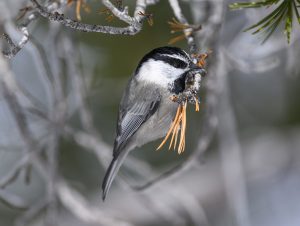Roadless initiative draws fire
Residents who attended a U.S. Forest Service presentation this week on President Clinton’s initiative to protect roadless areas in national forests said they have been given inadequate time to respond.
In October, Clinton announced a plan to protect 50 million acres of National Forest land that are designated “roadless.” This includes an estimated four to six million acres in California that were outlined in the 1970s in a series of Roadless Area Reviews and Evaluations (RARE I and II) conducted by the Forest Service.
The notice of intent was supposed to begin a period of public feedback in October, but Monday night’s meeting in the Truckee Sanitary District boardroom provided the first local public access to information about the plan’s effect on the Tahoe National Forest.
“October 19 to December 20 – 60 days approximately. This is seven days prior to the expiration (of the public comment period),” said Ken Wallace of Tahoe City. “Why is the Forest Service getting on this and calling these public meetings so very late and with very poor notification? Something’s a stacked deck here. Why didn’t they do this earlier on?”
Forest Service Public Affairs Officer, Ann Westling, said that as soon as the Forest Service was told to hold public meetings, it did.
“We’re just learning about this initiative as you folks are,” Westling said.
Wallace’s statement reflected cynicism that some opponents brought to the meeting. A vocal group of residents are outraged that the federal government may have the power to exclude recreational vehicles from a large portion of the Tahoe National Forest’s multiple use passages.
The eleven Tahoe National Forest lands being considered for roadless designation are the West and East Yuba, Bald Mountain, Grouse Lakes, the North Fork of the American River, Granite Chief, Duncan Canyon, the North Fork of the Middle Fork of the American River, Lakes Basin, Middle Yuba, and Castle Peak.
Arguments in favor of the proposal that motivated Clinton’s action are protection of clean water, biological diversity, wildlife habitat and other conservation concerns, according to the Forest Service’s notice of intent to prepare an Environmental Impact Statement (EIS).
“In my opinion, these roadless areas will become a very important factor in managing for wildlife species,” said Bill Baker, Tahoe National Forest Environmental Coordinator.
Multiple recreational users argue that the areas in question are not actually roadless, as they have 4-wheel and snowmobile-accessible paths. Forest Service representatives did not disagree that the definition of “roadless,” with regard to the Tahoe National Forest, is vague.
“I would acknowledge too, that many of the roadless areas are not roadless,” said presenter Larry Gruver, a Forest Engineer out of Nevada City. “Point in fact there are trails and roads in them.” He said the current definition of road used by the Forest Service is a treadway over 50 inches wide.
Monday’s presentation was to inform the public about the initiative and to encourage people to contact the national team that will decide the direction of the EIS. The presentation’s title, “Managing Roads and Roadless Areas: What do you think?” reflected this intention. The EIS will then create national guidelines that each Forest will apply to management of their regions.
“The Forest Service proposes to promulgate a rule that would initiate a two part process to protect roadless areas. If adopted, part one would immediately restrict certain activities, such as road construction, in unroaded portions of inventoried roadless areas,” the notice of intent to prepare an EIS stated. “Part two would establish national direction for managing inventoried roadless areas, and for determining whether and to what extent similar protections should be extended to uninventoried roadless areas.”
No Nevada County supervisors attended the meeting to voice their opinions. In a later interview, County Supervisor Sam Dardick said Nevada County policy has been in favor of protecting forests.
“We have a very environmentally concerned board of supervisors,” he said. “We need to protect old growth forests.” He said he feels there are many people who want to preserve and protect the Tahoe National Forest, including some of the motorized vehicle groups that speak against roadless and wilderness plans.
Supervisor Dardick also responded to concerns raised about the economic impact that roadless designation may have on the region. While opponents to the measure said they believe that roadless designation will be devastating to the economy because it will limit businesses that provide motorized recreation, Dardick said the forests need to be protected in order to foster the tourist industry.
While it may seem that there are only two sides to the issue, opponents acknowledge there is a willingness on the part of the Forest Service to consider the varying points of view on the issue, and said they will work with the federal agency.
“Off road vehicle people have been working with the Forest Service for years,” said Scott Denham, a member of the California-Nevada Snowmobile Association who has worked with the Forest Service on wilderness issues for nearly 20 years.
According to presenters Gruver and Westling, the national agency will seriously consider all comments and suggestions by the public.
Joanne Roubique, head ranger for the Truckee office of the U.S. Forest Service, said she believes that comments will be listened to in an effort to balance all sides. She said she was encouraged by the turnout at Monday’s meeting and called it the “democratic process at work.” She said it is impossible to really know what the effect on Truckee will be but it is clear that Clinton is responding to public desires and eventually the planning will reach the local level.
The Forest Service presentation provided the following questions as guidelines for people who wish to respond:
– What makes roadless areas important to you?
– How can we protect roadless areas in the most functional way?
– What should the EIS address?
– What do you like about the Forest Service proposal?
– What is missing or needs clarification?
– How would you like to be involved in the process?
– How should the Forest Service decide which roads are needed?
For information visit the website at http://www.roadless.fs.fed.us.
There are a variety of ways to relay comments on President Clinton’s roadless initiative before Dec. 20.
Fax letters to (801) 517-1021
E-mail to roadless/wo caet-slc@fs.fed.us
Mail letters to:
USDA Forest Service- CAET
attn: Roadless Areas NOI
P.O. Box 221090
Salt Lake City, Utah
84122
Support Local Journalism


Support Local Journalism
Readers around Lake Tahoe, Truckee, and beyond make the Sierra Sun's work possible. Your financial contribution supports our efforts to deliver quality, locally relevant journalism.
Now more than ever, your support is critical to help us keep our community informed about the evolving coronavirus pandemic and the impact it is having locally. Every contribution, however large or small, will make a difference.
Your donation will help us continue to cover COVID-19 and our other vital local news.









